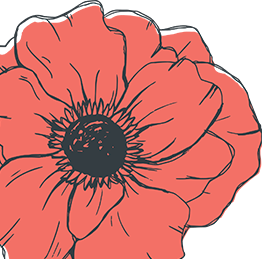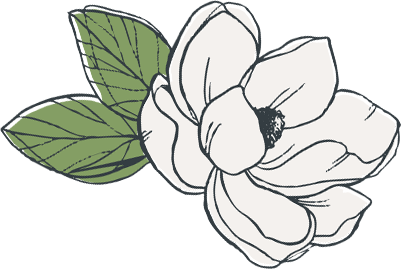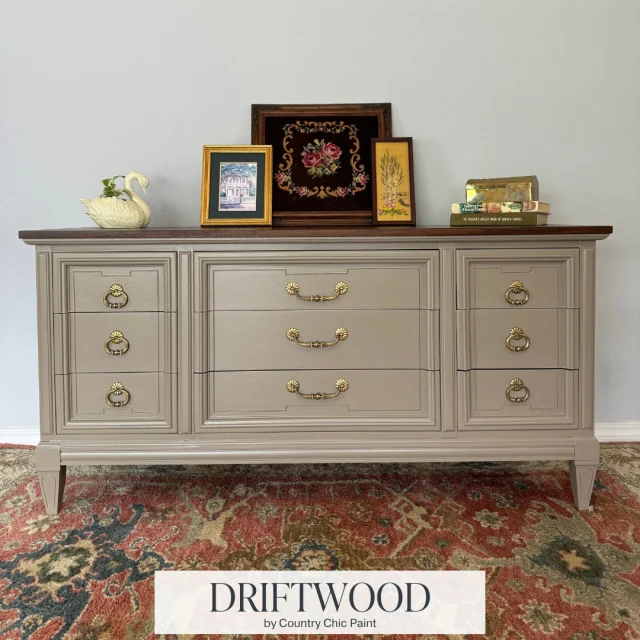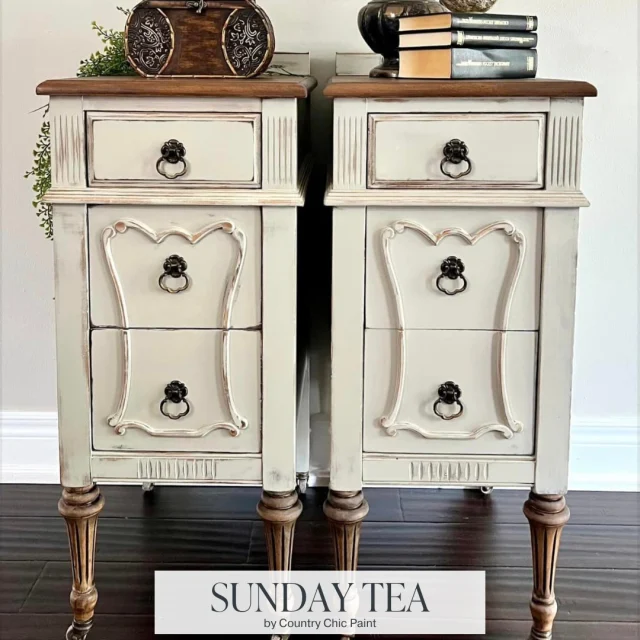Surface Prep Tips for Painting Furniture
In this tutorial we’ll show you how to properly prep your piece to ensure your beautiful work will last for years to come.
Before you do any sanding on an old piece of furniture, please make sure your paint doesn’t contain lead. Find out more about how to deal with lead paint here.

Step 1) Inspect for Mold
Inspect your piece for mildew & mold. If any is present, you can remove it with a denatured alcohol, bleach, vinegar or a commercial mold removal product.
Step 2) Deal with loose paint layers

Previous paint layers that are chipping or peeling off? It’s better to rid of the pieces that are loose as it’ll come off sooner or later anyway. Also make sure to sand the paint edges smooth.
Step 3) Removing hardware

Remove your hardware. Fill the holes with wood filler. Make sure to follow the instructions on the wood filler product, and sand it down nice and smooth.
Alternatively, you could paint over the hardware and save yourself the trouble of removing and replacing it.
Step 4) Clean your surface well

Carefully clean off any dust, dirt and grime with a solution of soap and water. Make sure that your surface is completely dry.
Step 5) Sanding & priming might be best
Which type of surface are you painting? The surface will determine what other prep is required. Below are some examples with recommendations on how to prep your piece before you start painting.
If you determine that using a primer will be the way to go for your project, make sure you check out this tutorial to learn all about our Clear Bonding Primer!
Unpainted wood or MDF
If there are any rough areas, you can sand them smooth, if desired. You’ll also want to make sure that your surface is clean and dry before you start painting! Not a lot of prep work at all!
Previously painted wood
If you know the previous paint is a water-based paint (just like ours), and has a low sheen (i.e. not glossy), then you can normally paint right over the painted surface. You can always test (see step 6) a small area first to check the adhesion.
If your surface is very glossy, it might have an oil-based paint on it. You can test this by taking a q-tip with some nail polish remover (NOT the acetone-free kind) or denatured alcohol and rubbing it on a small section of the painted surface. If the paint is water-based, you’ll notice a bit of the paint color on the q-tip; however when the previous paint layer is oil-based, then nothing will come off. Since our paint is water-based, and water and oil don’t mix well, you’ll need to make sure to thoroughly sand the original paint layer with 120 grit sandpaper, and let the paint dry for 4-5 days in between coats. This gives your paint the best adhesion possible. It might be better to prime your piece first if you are dealing with a solvent-based surface.
If your piece has a glossy finish, but is water-based, then we still recommend to sand your surface with 120 grit sandpaper to dull it down, so the paint has something to grab onto.
Laminated or melamine wood / particle board
Did you score a good deal at a garage sale, or pick up a bargain at a thrift store? Chances are that it’s a laminated surface. The majority of kitchen or bathroom cabinets are also laminated. Any laminated / non-wood surface should get a very light sanding with 120/180 grit sandpaper before painting. This will ensure that your paint adheres better to this non-porous surface. After sanding, make sure to clean off any dust and ensure your surface is clean and dry. Using a primer on these types of surfaces is a good idea, especially when they will get a lot of usage, such as cabinet doors.
Mahogany, knotted or stained wood
These types of wood will very likely cause “bleeding” when you paint them with a light color. Therefore, you’ll need to apply a stain-blocking primer (such as Shellac) before painting. If you started painting already and you notice any bleeding, simply stop painting and cover with a coat of stain-blocking primer. Once it’s dried, continue on with your project.
Step 6) Testing 123!

It is always a good idea to paint a small section to “test” how well your piece receives the paint. Let it dry overnight to see how well it sticks. The next morning, see if it rubs off when you run your fingernail across it. If it doesn’t stick well, then you’ll need to do a bit more prep work of sanding and/or priming for the best results.
Yes, I know, you want to get to painting right away… However, let’s be honest, it’s better to spend an extra 30 minutes prepping your piece than to be unhappy with how your piece turned out!
We have successfully painted all sorts of surfaces without any sanding or priming, so you certainly do not have to, because our paint adheres well to most surfaces. It is just better to be safe than sorry! So test your surface first and have fun with your painting projects!
Did you enjoy our video tutorial? Make sure to Subscribe to our YouTube channel to get access to all our videos!
We would love to hear what projects you’re working on, so make sure to leave a comment or post a picture of your project to our Facebook page or Instagram (@countrychicpaint)!













